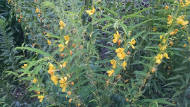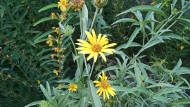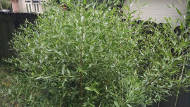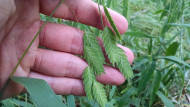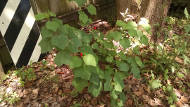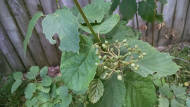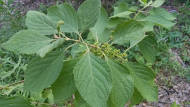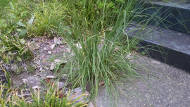A Better Sense of Place
2015 August 2 (Sun)
A hot, dry summer
A lot of plants found themselves put on my "At Risk" list this weekend. With temperatures rising to 95-100°F every day for the past 3 weeks and little rain for most of that time, I've decided to adjust my preference for what I plant and where. I know it takes a couple years for many plants to establish, so I'm not giving up on the newly planted stuff. Those guys generally need regular watering under dry conditions, even if they're native. And pretty much everything in a pot needs regular watering because their roots have limited reach. Also, established plants can go somewhat dormant in the heat of the summer and then come back to life when the temperatures start to lower again in the fall. So taking all of this into account, I've made a list of stand-out individuals and a list of questionable individuals.
I'll start with those that stand up surprisingly well in the heat, grouped by lighting conditions.
- Sunny
- broomsedge bluestem (Andropogon virginicus) — I'm impressed with grass. Broomsedge is definitely what made me sow seeds of more types of grasses: big bluestem, little bluestem, sideoats grama, gulf muhly, etc. When the dry, hot summer hits, grass explodes with growth.
- yaupon (Ilex vomitoria) — If I get my hands on another female, so I can get the bright red berries, I'm going to plant one in some blazing hot sun. (I have a female and a male, both in the shade, but I used to have a female in the alley before it was dug up and taken away.)
- partridge pea (Chamaecrista fasciculata) — Their leaves flatten out in the midday sun to limit water loss, but they do not wilt. They're annuals that don't need water. It's Crazy Land.
- groundsel (Baccharis halimifolia) — I'm not sure this species gets any respect, but it can take full frontal sun.
- goldenrod — I'm still working out what companions these need to stand up straight — a tall grass? — but they don't mind the dry heat.
- ironweed (Vernonia sp.) — Another one that doesn't mind getting zero shade.
- lanceleaf coreopsis (Coreopsis lanceolata) — They've stopped flowering, but they're evergreen and aren't phased by full sun.
- willowleaf aster (Symphyotrichum praealtum) — A strong volunteer.
- Shady
- coralbean (Erythrina herbacea) — I thought these would do well in the sun, which is why I had planted 2 in the alley beginning of last year. But this year, I planted one in dappled shade, and it's doing wonderfully.
- American beautyberry (Callicarpa americana) — I have two in the sun, but the ones in the shade are looking a lot better.
- arrowwood viburnum (Viburnum dentatum) — None of the three I planted ever need water, even the little one I just planted in December.
- Virginia sweetspire (Itea virginica) — When I wash out and refill my bird bath, I dump the old water onto the two sweetspires. I'm not sure if this is the reason why they're doing so well.
- inland sea oats (Chasmanthium latifolium) — These need to take over. I likes them.
- Turk's cap (Malvaviscus arboreus var. drummondii) — I moved one from the alley 3 years ago and put it in the shade. They do pretty well in the sun, but they seem happier in the shade.
As for what is now on my "At Risk" list, here they are.
- Carolina buckthorn (Frangula caroliniana) — This has been in the front yard sun way too long. It's somehow survived, but it's time to give it a better life as an actual understory tree this winter.
- sassafras (Sassafras albidum) — I've probably been ignoring this a bit too much. It looks so thirsty and has very few leaves.
- witch hazel (Hamamelis virginiana) — I accidentally clipped it with a string trimmer this year. It lost a bunch of leaves and has some new shoots beneath the cut.
- every single red buckeye (Aesculus pavia) — I just can't find a good spot for these. They keep dying on me.
- Japanese snowball (Viburnum plicatum) — I'm not watering it. It is now wilting. I will replace it this fall with a pawpaw.
- mayhaw (Crataegus opaca) — I don't know. More water? It's in a brutal spot with direct sun and reflected sun.
- oakleaf hydrangea (Hydrangea quercifolia) — Something keeps eating all of them. I may just give up and go with beautyberry instead.
- glossy abelia (Abelia x grandiflora) — I think it's time to kill all four. I've already dug one up and replaced it with a Turk's cap. They can't take this weather and have lost most of their leaves, leaving ugly sticks. I'm considering gulf muhly and purple coneflower or something.
- red chokeberry (Photinia pyrifolia) — I planted it in too much shade, I think. It's not dying, but it's not pleased.
They didn't make it on my "At Risk" list because I didn't plant them, but the woodland lettuce (Lactuca floridana) and lateflowering throroughwort (Eupatorium serotinum) are generally having a hard, dry time out there. Some aren't even in the sun but under the live oak. Wilty wilty leaves. But I think they might actually survive the summer.
Next, I think I'm going to acquire a blackgum (Nyssa sylvatica), a toothache tree (Zanthoxylum clava-herculis), gulf muhly, a pawpaw, a couple Adam's needle (probably), a female yaupon, maybe a wax myrtle, and a spicebush. I'll plant some more American beautyberries that I grew from cuttings and seed. And I look forward to seeing all the sown grass grow. Grasses are the future.
